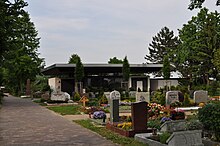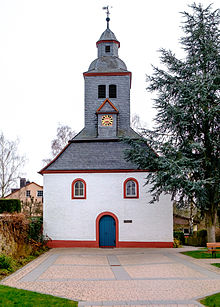Dornholzhausen (Bad Homburg)
|
Dornholzhausen
City of Bad Homburg vor der Höhe
|
|
|---|---|
| Coordinates: 50 ° 14 ′ 20 ″ N , 8 ° 35 ′ 11 ″ E | |
| Height : | 213 m above sea level NHN |
| Area : | 9.43 km² |
| Residents : | 4346 (Dec. 31, 2006) |
| Population density : | 461 inhabitants / km² |
| Incorporation : | December 31, 1971 |
| Postal code : | 61350 |
| Area code : | 06172 |
Dornholzhausen is a district of the city of Bad Homburg vor der Höhe in the Hochtaunuskreis and lies below the Saalburg im Taunus in Hesse .
geography
Dornholzhausen is located in the north-west of Bad Homburg vor der Höhe and has 4,346 inhabitants (as of December 31, 2006). Dornholzhausen is separated from the rest of the Homburg urban area by the federal highway 456 , to the west of Dornholzhausen lies the Oberstedten district of Oberursel , otherwise the district is surrounded by the forests of the Taunus. Essentially, Dornholzhausen is an upscale residential area with single or multi-family houses, sometimes also villas. Only in the town center are there larger residential complexes and two high-rise buildings. In 2006 a new shop and business center was built on Lindenallee.
In terms of traffic, Dornholzhausen can be easily reached from the federal highway 661 and then via the federal highway 456. Public transport users can reach Dornholzhausen with the city bus routes 1, 11, 21 (night bus) and 31 (school bus). There are also night bus routes n32 to Frankfurt am Main and n34 to Usingen and Neu-Anspach.
history
Already in 1222 a village called Dürreholzhusin was mentioned in the area of today's Dornholzhausen . It belonged to the Homburg office .
In 1486, Gottfried X. von Eppstein, with the consent of the feudal lord , the Hessian landgrave , sold the Homburg office and the associated villages - including Dornholzhausen - for 19,000 guilders to Count Philipp I (the younger) von Hanau-Münzenberg . The Hanau counts did not keep the office long. In 1504 Hanau was defeated in the Landshut War of Succession , Landgrave Wilhelm II of Hesse, on the other hand, stood on the side of the victors and confiscated the office. At the Diet of Worms in 1521 a settlement was reached through the mediation of Emperor Charles V : The Counts of Hanau waived their claims in return for payment of 12,000 florins.
In 1699, Landgrave Friedrich II of Hessen-Homburg allowed French religious refugees, the Waldensians , to settle here. The first residential buildings that have been preserved to this day were built around the area of today's Dornholzhäuser Straße. In 1726, today's Waldensian Church was finally built. The village was taught and worshiped in French until the end of the 19th century .
From 1899 to 1935 Dornholzhausen was connected to the Bad Homburg vor der Höhe tram network, which first had its terminus at the Gotisches Haus and from June 3, 1900 went to the Saalburg.
The Victoria-Pensionat, founded by Empress Friedrich in Kronthal near Kronberg im Taunus in 1890 , moved to Dornholzhausen in 1897. The empress continued to take over the protectorate for this teaching institute, which attracted many " higher daughters ". With the beginning of the First World War , teaching was discontinued and a hospital was set up in the house . In 1920 the Victoria boarding school was completely closed and the “Haus Elim”, a household and cooking school run by the Marburg Blue Sisters, was set up. During the Second World War it was used again as a hospital and later as a convalescent home. In 1956 it was acquired by Peters Pneu Renova and served as an administration building. In March 1981 the building burned down completely.
On December 31, 1971, the previously independent municipality of Dornholzhausen / Taunus was incorporated into Bad Homburg as part of the regional reform in Hesse .
leisure
Dornholzhausen has tennis courts and a football field at sports facilities. The operation of an ice rink was stopped in winter 2004. The Northwest Sports Center is located between Dornholzhausen and Kirdorf .
The Dornholzhäuser club life is diverse. There is a volunteer fire brigade , song wreath, history circle, scouts Taunus scouts eV tribe "Franz von Assisi". The golf course in the Röderwiesen is operated by the Homburger Golf Club 1899 , the oldest golf club in Germany , which began in the Bad Homburg spa gardens . There are still playable parts of the old golf course, as well as the old clubhouse, now a restaurant.
The bush meadows are also a well-known local recreation area in the surrounding area. The surrounding area, which was affected by the wild barbecuing, and the increased risk of forest fires prompted the city of Bad Homburg in 2006 to decide on permanently designated barbecue areas and a toilet block. The barbecue areas have already been created and are very popular.
Infrastructure
graveyard
There is a war memorial in the cemetery . Next to it is a memorial for the deceased Waldensians. It consists of a number of old grave slabs that are attached to the cemetery wall around Anna Deisel's grave. In 2012, the grave slabs were renovated and installed as a memorial at today's location. They are part of the European cultural long-distance hiking trail Huguenots and Waldensians .
Attractions
- Gothic house - castle in Dornholzhausen
- Hirschgarten Dornholzhausen - animal enclosure, mini golf course and restaurant
- Erlenhof stud
- Waldensian Church
literature
- Jutta Brod and Britta Schack: Dornholzhausen and Walldorf - two Waldensian settlements between originality and growth . In: Monument Preservation and Cultural History 4/2018, pp. 28–33.
Web links
- The place on the Bad Homburg website
- "Dornholzhausen, Hochtaunuskreis". Historical local dictionary for Hessen. In: Landesgeschichtliches Informationssystem Hessen (LAGIS).
- Literature about Dornholzhausen in the Hessian Bibliography
Individual evidence
- ↑ "Dornholzhausen, Hochtaunuskreis". Historical local dictionary for Hessen. (As of February 17, 2014). In: Landesgeschichtliches Informationssystem Hessen (LAGIS).
- ^ Uta Löwenstein: County Hanau . In: Knights, Counts and Princes - Secular Dominions in the Hessian Area approx. 900–1806 = Handbook of Hessian History 3 = Publications of the Historical Commission for Hesse 63. Marburg 2014. ISBN 978-3-942225-17-5 , p. 211 .
- ↑ The Waldensian Church
- ↑ Gerstenmeier, K.-H. (1977): Hessen. Municipalities and counties after the regional reform. A documentation. Melsungen. P. 267
- ↑ The grave slabs of the Waldensians; in: Taunus-Zeitung of November 22, 2012, p. 14





